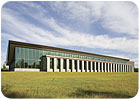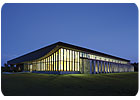
Photos by Jonathan Hillyer/Atlanta
Construction of a new Georgia Public Health Laboratory (GPHL) in Waycross, GA, was recently completed, and the building was designed to be a “sister” facility to the main Public Health Laboratory in Decatur, GA. As a result, the new structure is similar in both physical appearance and internal design so that if the Decatur facility were to become non-functional, staff and equipment could be transported into comparable space at this alternate location, and resume research with minimal retraining time. And to mimic the architecture of the original building, Rubble Stone - comprised of granite pieces that included scrap material and byproducts from other stoneworking processes - was employed for the exterior facade of the 23,840-square-foot Waycross facility.
“One of the main driving objectives for the design of the building was to be a sister facility to the Laboratory in Decatur,” said Principal-in-Charge Warren Williams of Lord, Aeck & Sargent of Atlanta, GA, which was also responsible for the design of the facility in Decatur. “The Decatur facility was intended to serve the state. This sister facility is going to primarily serve the southern part of the state.”
Williams went on to say that the site of the Waycross facility was actually donated to the state by Waycross-Ware County Development Authority, and it is also the first building that was constructed on the property. Future plans for the site involve developing an industrial/business office park.
“[The new building] is similar to the way that we designed the Decatur facility,” said the architect. “The offices face west, so they receive a lot of natural daylight. We used the stone to control the daylight to minimize the heat gain in the offices.”

The selection process
Williams explained that the decision to use salvaged granite was made back in 1998, when planning began on the GPHL Decatur building. The Waycross facility was designed with sustainable building design concepts in mind.“Waycross is meant to look like the Decatur facility, so to use [salvaged stone] again was to relate it to the building, since the two buildings work together,” he said. “The GPHL in Waycross is designed to act as a surge facility to the Laboratory in Decatur.”
One of the challenging aspects of the project was to ensure that the Rubble Stone pieces used for the Waycross facility matched the stone facade in Decatur, according to Williams, who added that he spent a fair amount of time onsite supervising the installation. As a result, a mock-up on an existing wall was completed as a point of reference.
“We were really maintaining the look and feel that we were striving for to match the Decatur building,” he said. “There are square-shaped pieces that are laid in a random pattern. This feature gives the building a really rich texture, and makes for a very durable exterior wall surface.”

The installation
According to Project Manager Bruce Margol of Paverstone Construction in Atlanta, GA, the company responsible for the stone installation, the Rubble Stone was delivered to the jobsite in truckloads. “This particular stone is smooth on two sides and rough on the other side,” he said. “We still had to work it. We cut [the pieces] down with saws and used chipping hammers to work them.”Margol went on to explain that his crew, which averaged six to eight workers each day, went to the jobsite six weeks early to build a mock-up on an existing wall that had been recently built. “It’s better to do it that way,” said the installer. This way, if the mock-up is correct, it is already on the structure.
“[The installation] was pretty straightforward,” Margol continued. “Lord, Aeck & Sargent is good with specifications and drawings. We used stainless steel wall anchors to secure the stone to the wall.”
Margol explained that the stone was laid in a random ashlar pattern. “A unique feature that Lord, Aeck & Sargent wanted us to do was to not make [the pieces] even,” he said. “They were laid in a random in-and-out [pattern]. The corners are not 90 degrees.”
In total, the stonework was installed in approximately three months. “The project went fairly smoothly,” said Margol.
From start to finish, the entire project took about a year and a half. It began in January of 2006 and was completed in July of 2007. “It has been very well received,” said Williams. “They had a really nice ribbon-cutting [ceremony], as they do with all State projects. The community had very nice things to say.”
Georgia Public Health Laboratory
Waycross, GAArchitect: Lord, Aeck & Sargent, Atlanta, GA
Stone Installer: Paverstone Construction, Atlanta, GA
